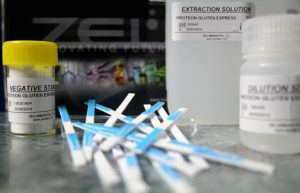Food allergens are components of foodstuff and additives that when digested, in contact or inhale cause an immune reaction known as food allergy.
Although some allergies occur more frequently than others, and there are about 160 foods that can cause allergic reactions, the most common ones are those to the cow milk, eggs, legumes (including soy), wheat/gluten, fish, shellfish, fruits, and nuts, such as peanuts and walnuts.
The declaration of allergens is mandatory, even if the possibility of the allergen to be present is small. At present, European regulation No 1169/2011 expands the UE Regulation with specific requirements regarding the declaration of allergens in food. This regulation insists on most food allergy incidents can be traced back to non-prepacked food.
The information on potential allergens is considered very important and affects both commercial and collective catering service, retailers selling unpackaged food, and official labeling. In order to ensure a high level of protection for consumers and to facilitate their choice, products put on the market must be safe and adequately labeled: any substance or ingredient causing intolerances or allergies used in the manufacture or preparation of a food and still present in the finished product, even if in an altered form, must be declared.
There are several methods for assessing the presence of allergens in food matrices, surfaces and rinsing waters, which are grouped into two:
- Direct methods detect allergenic proteins (gluten, soy, milk β-lactoglobulin, etc.) in a specific and sensitive way. Some of these methods are:
-
Rapid immunochromatographic strips test (presence/absence of allergen). It is an immunochemical technique which uses specific antibodies. They are really easy-to-use test and can be easily run on-site as not qualified personnel, neither laboratory equipment is needed.
-
ELISA kits (quantitative analysis of specific allergens). It is also an immunochemical technique. They require laboratory equipment and qualified personnel
-
Mass spectrometry, which require highly qualified personnel and highly expensive laboratory equipment.
- Indirect methods do not detect allergenic proteins:
Detection of ATP, a molecule used by all living organisms to provide energy in chemical reactions, is considered an indirect method. However, this technique is not allergen specific and it is only useful for indicating the cleanliness level, so that it should not be considered as such.
Every method has advantages and disadvantages according to their rapidity, reliability, ease of use, etc. There is not a perfect method but some of them can suit better than others the users’ needs.

Customers must be informed on specific allergens. On this basis, direct detection methods would be the appropriate techniques to correctly and specifically declare the allergens which may be present in a product or a meal. In addition, direct detection methods are more sensitive and avoid false positives, as they distinguish the specific presence of allergens.
Food and Drink Europe launched in 2013 its Guidance on Food Allergen Management for Food Manufacturers. This guide recommends the use of on-site rapid strips LFIC for routine check-ups and ELISA kits for result confirmation on a regular basis.
In case of ambiguous results, it is advisable to carry out confirmatory tests by PCR. However, because of the low sensitivity of the PCR technique for certain allergens, it should only be used when no other detection technology is available.

